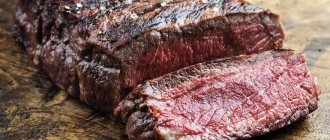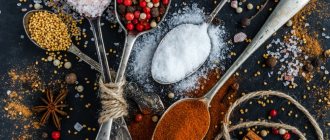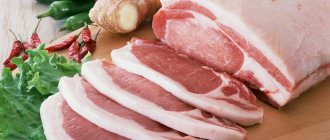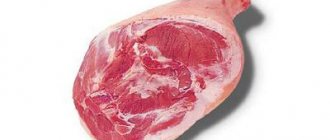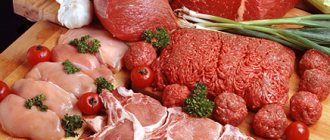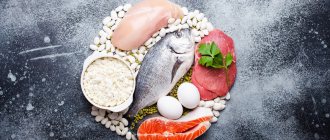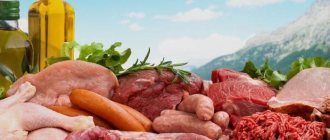Pork is widely popular due to its taste, the ability to prepare a large number of different dishes from it, and its affordable cost. You need to know that there are several types of meat, as well as parts, each of which has specific uses in cooking. We invite you to get acquainted with the diagram of the parts of a pig carcass, find out which of them are more valuable and tasty, and in which dishes they are usually used.
Characteristics of pork categories
Pork is easily digestible by the human body, has many beneficial properties, and is considered a natural antidepressant.
Types of meat
In industry, it is customary to distinguish two varieties:
- First. Differs in dietary properties. This includes: ham, as well as tenderloin from the shoulder blades, loin, back, and brisket. Ideal for baking, stewing, frying.
- Second. The fat and fiber content here is slightly higher, so it is used for the production of semi-finished products, soups, and minced meat. This variety includes: knuckle, neck and shank.
The butchering process begins with skinning the animal, then carefully removing the internal organs. Next, the body is divided into certain parts, each of which has its own name and purpose. In addition, the animal also allows you to get lard.
Pork is also divided into categories:
- boar meat;
- suckling piglets;
- sows;
- hogs;
- gilts
This classification is based on the age of the animal, sex, and carcass weight.
Location and features of parts
Let's find out which part of the pig is better - the front or the back. Different parts of the carcass differ in taste, but a general rule can be identified - those that are completely static and do not participate in the movement of the animal are considered the most delicious. Read the description of the main ones.
Head
Most often it goes on sale whole, sometimes cut in two.
The most valuable products are:
Some people treat the head as an unvaluable product, but such an understanding is unfair. If you cut it up and cook it correctly, you can get a lot of interesting dishes. The only thing that cannot be used in cooking is the jaw.
Neck-scapula cut
Includes the following parts:
- Neck. Very juicy and tender meat, distinguished by high fat content. When sold, it may be called a collar; in this case, it is meat from the neck portion cooked in the form of bacon.
- The shoulder blade is boneless. The meat is quite tough, not suitable for delicacies; it is used for making sausages and jellied meats. It is also permissible to stew it, boil it, fry it.
- Shoulder blade on bone. Rough, needs careful processing, most often used in portions or whole for smoking.
Korean
Let's look at what pork loin is and what part of the carcass it is. According to the diagram, this is a section of the back that includes ribs and cutlet meat. It is used both whole and in pieces for smoking and frying.
The boneless part includes fragments:
- “thick place” - located closer to the head;
- “thin place” - located at the back of the carcass. It is a tender meat that can be used for steaks and goulash. The whole piece is also baked.
The tenderloin between the backbone and ribs is a wonderful entrecote for roasting.
Carbonade
Let's look at what carbonate is and what part of pork it is. This is a fragment of the lumbar cut, including loin, often baked or fried. The presence of a small amount of fat is acceptable - no more than 5 cm. The physiology of a pig is such that during its life the back muscles are practically not used, so the fibers here are soft, and due to the absence of fatty layers, the meat becomes less caloric.
The loin and the carbonate are one part of the carcass, but the carbonade is the loin without the bone.
Ham
It can be on the bone, in this case it is used for smoking, stewing or frying whole or divided into two parts. Boneless ham is a loin that is suitable for cooking over an open fire, as well as for schnitzels and escalopes. Baked pork is also made from boneless ham.
Sternum
This is the thick part of the peritoneum located close to the lower back. It is very rich in fat, used for smoking and frying, baking in foil. Brisket in onion skins is very good.
Tenderloin
You can't tell where it is from a photo of a pig cutout. However, the tenderloin is considered one of the best parts of the carcass; it is located at the back above the kidneys and has a very delicate taste, for which it is valued. When purchasing, it is important to pay attention to the size of the pieces - very large ones were taken from an old animal, so it is better not to choose them.
The cost of tenderloin is more expensive than brisket, but the number of dishes that can be prepared from it is simply enormous. These are medallions and shish kebab. In addition, the meat can be fried or cured in an original way.
Ribs
Piggy ribs are perfect for smoking, frying, baking with vegetables and mushrooms. They can also be cooked together with other parts of the carcass; in addition, the broth is very tasty and aromatic.
Now let’s figure out what a knuckle is, what part of the pig it is. It is coarse meat that requires careful cooking and is classified as second grade. The shank from the hind legs is also called shank; it has more meat, which is why it is used in cooking. Most often, this part of the carcass is sold chopped into small pieces.
Korean
The best parts of pork meat include the back area. It includes the ribs, meat and thoracic spine.
There are two types of back section: loin with bones and carbonade without bones. The entrecote area between the ribs and the ridge is also cut out.
The meat is tender, with a low fat content of 21 g per 100 g. Calorie content 199 kcal.
Before sale, the fat is cut off from the loin and a layer of 0.1-0.2 mm is left. Lard adds juiciness to dishes.
What is better to use
Having examined the cutting diagram, we will determine which parts of the pig carcass are best to choose for preparing various dishes.
The most tender
The softest and most delicious parts are considered to be:
- Neck. A very juicy area that is used for stewing, boiling, frying.
- Korean. Almost free of fat, ideal for preparing medallions, pilaf, and stews.
- Tenderloin. The most appetizing, although expensive, area of the pork carcass.
The most delicious and tender meat is taken from those parts that were not involved in the movement process.
Top or bottom
There is no definite answer to this question, since it all depends on the dish that you plan to prepare. The upper part includes the loin and the carbonate, the difference between which was discussed above. They are the ones that are highly valued in cooking, in contrast to the shoulder and shank located below.
For barbecue
It is best to prepare shish kebab from the following pieces:
Kebab masters share a secret - the best option is the neck, which contains a large amount of fat layers for the most appetizing kebab. Therefore, if possible, you should always purchase it. If you have to work with the shoulder area, then a kiwi marinade will help make this harsh meat more tender, in which the cut pieces are kept for no more than 2 hours (if you overdo it, the meat will spread through the fibers).
For the chops
What part of the pork is used to make chops? First of all, this is the cervical region, as well as the ham and shoulder. Delicious upholstery can also be obtained from fillet, which is previously beaten with a hammer.
Culinary uses of other parts
The loin section of the ham (the so-called butt) can be used for schnitzels and steaks.
The scapular fragment is most often used to make:
The lumbar areas are good for frying; they can also be cooked over coals. The ham is most often used in its entirety and is good for soups. By cutting the loin into 3 cm pieces, you can make very tasty bone-in pork cutlets.
Tender pork neck allows you to prepare a huge number of dishes:
- escalope;
- steaks (both for the grill and for the stove);
- meat cut into thin slices is ideal for frying.
Its dishes are very high in calories and contain a lot of fat.
A whole range of authentic delicacies can be prepared from a pig's head. For example, ears, which are first boiled, then breaded with breadcrumbs and grilled. Cheeks and snouts are no less delicious (for example, in sour cream sauce with zucchini and onions). Most often, meat from this part is used for jellies.
The best part of the carcass for cooking oven-baked pork (meat baked with spices in the oven) is the ham. Although, if desired, you can use other juicy and tender pieces.
Tenderloin
The most tender part of the carcass. It is located above the central section of the ridge and is covered with a layer of fat.
Throughout the life of the sow and boar, this area of the body is not exposed to physical stress. Therefore, the meat is soft and practically free of fat, 7 g per 100 g of meat. Tenderloin is included in weight loss diets.
Calorie content 199 kcal per 100.
The tenderloin is fried and cut into medallions. Due to the high cost of meat, cooking goulash is unprofitable.
Video
In the next video you can see a diagram of the most and least useful fragments of a pig carcass.
The recipe for fried pork cheeks is presented in the video below.
Pork is one of the most common meat products in the world. Raising pigs for slaughter is a popular activity among farmers, because pigs are unpretentious in food, do not require special care and quickly gain weight. What is the leanest part of a pig carcass?
The carcasses of these animals have leaner and fattier parts. The least amount of fat is contained in the following pieces:
- the leanest part of pork is the tenderloin, which is boiled, stewed, fried, baked, made into kebabs, that is, it can be prepared in any way;
- in second place is the spatula, it is also suitable for any food;
- carbonate has a fat layer of approximately 0.5 cm, it is usually baked or cooked over a fire;
- the loin contains 4% fat, it is used for chops, meat rolls, stews, cut into layers or pieces.
You can and even should use lean pork to feed children - it has a good effect on metabolism, improves immunity, and contains a large amount of easily digestible protein, vitamins, macro- and microelements. BJU for lean pork - 0: 19.4: 7.1.
Beneficial features
After lamb, lean pork meat is in second place in terms of absorption by the human body. At the same time, it has a very small amount of fat, slightly more than in chicken meat.
Its use in the diet has a good effect on the human nervous system, makes it possible to rest well at night, restores normal sleep, participates in the process of restoration of liver cells, and helps improve fat metabolism in the body.
Lean pork also strengthens the human immune system, stops the appearance of tumors, and speeds up metabolism. Zinc improves the condition of the skin and is considered a natural antioxidant.
Lean pork speeds up metabolism
Iron and zinc take part in hematopoiesis; these elements are sufficient in this meat product. They are also a good prevention of anemia.
How to cook profitably?
You can prepare a wide variety of dishes from lean pork. Below are recipes for some of them.
Lenten dish with vegetables in foil
Ingredients:
- lean pork – 1 kg;
- carrots – 2 pieces;
- potatoes - 3 medium-sized pieces;
- sweet bell pepper – 2 pieces;
- tomato – 2 pieces;
- large onion;
- a bunch of fresh mixed greens;
- salt.
Wash the meat, dry it and cut it into large cubes. Wash all vegetables, remove peels and husks. Chop the onion into half rings, potatoes into slices, carrots and peppers into strips. Remove the skin from the tomatoes, then chop. Chop the greens.
Pork varieties
In the food industry, it is customary to distinguish 2 main types of pork. 1st grade pork is the most healthy and dietary meat, which includes cuts from the back, shoulder, lumbar, sternum, as well as ham. This meat is eaten independently - it is stewed, fried, boiled, baked.
The second grade of pork is the fattier parts of the pig's body that have more fiber. These include shank, shank and neck. Most often, such parts are used for preparing minced meat or adding to soups.
Divide pigs into categories based on their sex and age. They can pay attention to the weight and amount of fat in the animal.
Thus, the following varieties of pork are distinguished: meat of boars, suckling pigs, young animals and such products that are used mainly for processing.
Choosing meat
When buying pork, you need to pay attention to the color of the meat. If it is light, then the pig was young, and if it is dark with yellow fat, then it is old.
Fresh and high-quality meat - dense and elastic. There should be no films or unpleasant odor. If you press on it with your finger, the resulting hole quickly levels out. A stale product will have a pressure mark left behind.
Good pork may have veins that resemble marble. Fat on fresh meat should be white. Other shades (cream, gray, beige) are not welcome.
Unscrupulous sellers may refresh pork with a solution of potassium permanganate. In this case, the unpleasant smell of old meat disappears. But the lard changes its shade and will not be white.
We also recommend that you read the article “Rendering pork fat.”
If you liked the article, then like it.
We are waiting for your feedback on the topic of lean pork.
Pork is one of the most controversial meats. There are almost more bans on its use in different countries of the world than on the meat of any other domestic animals. And yet, in popularity it is not inferior to beef, poultry and lamb.
Why is it banned? And what effect does the composition of pork have on our body?
Vitamins and minerals in pork
Pork contains many mineral components and vitamins. These include B vitamins, namely: B1, B2, B5, B6, B9, B12, PP.
The vitamin composition of pork is superior to beef. Pork contains calcium, magnesium, phosphorus, potassium, sodium, sulfur, zinc and iodine.
Lard has brought particular fame to pork. But this does not mean that pork is a fatty product. If you remove the fat layer from the carcass, leaving clean meat, then the calorie content of pork will be about 350 kcal. Pork meat without fat is lean and healthy. This feature of pork makes it a universal product: both fatty and dietary. However, if you do not remove fat layers from meat, then the calorie content of pork will not please you. It will be approximately 490 kcal.
The amount of protein in pork makes it attractive to athletes. It is also recommended to add pork meat to the diet of children. Protein is the main building material that helps form tissue in the body.
The benefits of pork
The first thing that all nutritionists pay attention to is the ease of digestibility of pork. Its fat is lard, its composition is ideal for the human body; it is quickly absorbed and saturates the body with energy and strength. Lard puts a slight strain on the digestive tract, which provides protection against intestinal pathologies and indigestion.
The meat itself contains some bad cholesterol, since its entire supply is in lard. Therefore, if you have heart or vascular diseases, it is better to eat lean pork. And when consumed regularly, pork feet help increase breast milk production in women. That is why doctors advise pampering a woman with jellied meat once or twice a week during lactation.
Compatibility
For food to be healthy, you need to know how to choose side dishes. Compatriots are accustomed to combining fatty pork meat with potatoes or pasta. In a couple of weeks, such variety will “delight” gourmets with a few extra pounds. It is important to remember that the ideal dish should not be harmful.
The product does not go well with any type of fish, desserts or confectionery. When creating culinary recipes, many cooks prefer to add fruits, honey and nuts. Unusual notes to the fibers give the sweetish-sour taste of pineapple or the sugary aroma of prunes.
In German cuisine, pork is eaten with sauerkraut. Thanks to this combination, it is possible to reduce the load on the gastrointestinal tract. The acidic environment of vegetables helps to quickly break down meat of any fat content.
Kebabs are a favorite dish of our compatriots, but they are not always healthy. Harm comes from preservatives that form on the surface after contact with a flame. Soaking in marinades and an abundance of spices causes irreparable damage to the body. As an alternative, doctors recommend grilling it with vegetables.
